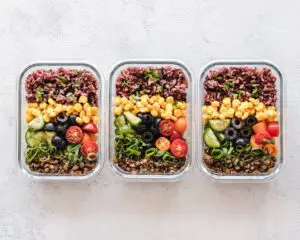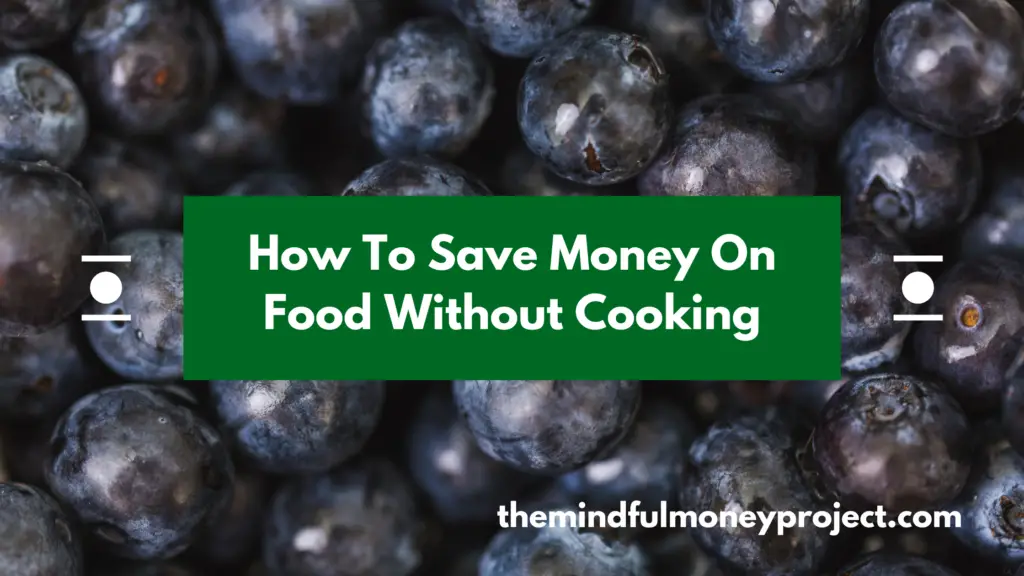Food is often one of our biggest expenses. A burrito here and a burger there sure do add up quickly over the course of a month. With massive food inflation seen recently, this is an area a lot of people want to get a handle on. But what if you hate cooking and want to reduce your costs without turning to the kitchen?
How To Save Money On Food Without Cooking
Canteen subsidies
If you are working in an office, a lot of employers will subsidise your canteen. Better yet, they may provide free food.
Make sure you take advantage of these perks. If your canteen is subsidised, then this will likely save you a LOT if you eat lunch (and even dinner if you work late) compared to eating out at a standard restaurant.

Get thrown out food
Admittedly this sounds worse than it is. Every day, catering businesses, restaurants and cafes have to throw out food that has not been sold. They tend to throw them out because they either pride themselves on selling fresh food (and therefore can’t keep it to sell the next day), or they’re nearing (or have exceeded) the expiry date.
A lot of the time the expiry date doesn’t mean the food has spoiled or cannot be eaten.
Therefore, this food waste is unnecessary. New services and apps have cropped up to help reduce this level of food waste. It helps connect businesses who are throwing food away, with hungry punters (like yourself) who can help take it off their hands.
You’ll have to be quick though. Because stock is volatile and unpredictable, it’s a first come first serve basis!
Some of the leading apps to try:
For the food being offered free or for a heavily discounted price, you can save potentially hundreds of pounds a month compared to eating out at restaurants or cafes.

Fight food waste at home
So admittedly this involves the kitchen. But according to Love Food Hate Waste, we waste 6.5 million tonnes of food in the UK alone each year.
Not only does this have a staggering impact on the environment, but also on your wallet. If your average food budget is £100 per week but you end up throwing away 30% of each shop, you’re essentially throwing £30 away each and every week. In this example, that adds up to £1,560 per year!
Putting in place a system to make better use of the food you do have can pay dividends worth hundreds or even thousands of pounds a year.
Some apps have sprung up helping tackle the problem of food waste in homes. Some for you to try are:
Also try to freeze any leftovers so you have something ready to go when you need it.

Look for restaurant loyalty schemes
If you hate cooking so much that you refuse to do it, then look for restaurants that run loyalty schemes. Typically, they’ll reward you with a free meal (or part of one) for every x number of meals.
For example, Nando’s run a loyalty scheme in the UK where you earn rewards for every three visits.
There is a roundup on the best restaurant loyalty programmes, but beware, they’re not particularly healthy food establishments, with most fast food.
Look for the reduced section
If you have a supermarket close to you, then try to figure out the best times to shop to get the best reduced items.
Each day, supermarkets will discount some items which are getting close to their used by date. This increases the likelihood they will sell and reduces their level of wastage.
For you, however, it is a ticket to some cheap food.
Using this analysis from Skint Dad, the best time to go food shopping to snag discounts is generally the evening between 7pm and 8pm.
Swap a meal out for a (pre-prepared) meal in
Generally, food prepared at home will cost you a lot less than eating out at a restaurant and cafe. This is because they have to pay the costs of running the premises and for the chef’s salaries. Any restaurants that do work out cheaper, tend to be due to the poor quality of food on offer.
However, just because you prepare a meal at home doesn’t mean you need to cook it.
How about ready meals and pre-prepared foods?
Long gone are the days of ready meals being exclusively poor quality, heavily processed food freezer meals that are no good for you. There are healthy alternatives available in most large supermarkets.
Whilst these prepared meals are more expensive than cooking them yourself, they will be significantly cheaper than going to a restaurant.
In terms of cooking? All you’ll need is a microwave and less than five minutes.

Online subscription options
If you’re really short on time and don’t want to even go to the supermarket, there are online subscription options that deliver for convenience.
Once again, these are more expensive than cooking for yourself (or getting a cheap and cheerful frozen version from a supermarket), but they should be of better quality and some of the options use only fresh produce.
Some of the more common services you can check out:
Bag a special promotion
If eating out at restaurants really is your bag, then do a quick check upfront to see if any special promotions are on.
Great sites to check include:
Turn to frozen food
Once again slightly cheating as this involves cooking. But if you have access to a freezer and basic cooking facilities such as a microwave or an oven, then frozen food could be your saviour.
If you’re often out and about with a busy lifestyle, you may not want to cook because of the time constraint.
There are plenty of healthy freezer foods available in most supermarkets (not the processed crap). Allowing you to knock up a healthy meal within twenty minutes by simply turning the oven on.
See above for some suggestions of pre-prepared online brands that ship chilled or frozen ready meals.
Meal Replacements
Meal replacement shakes are a debatable topic. On the one hand, they are very convenient and can be effective in helping aid goals such as weight loss.
On the other, they typically contain artificial ingredients and are therefore heavily processed.
You should carry out your own research before using any particular product – and given the uncertainties over the health benefits restricting your usage to no more than one meal replacement a day is probably a prudent approach.
One of the more popular brands in the UK is Huel (you’ve probably seen some people walking around with the t-shirt). They offer a range of meal replacement shakes that are high in protein, as well as branching out into prep-prepared meals too.
If you’re short on time, these can be a great way to get a hit of food in the quickest and most convenient way possible. All you need is a shaker and some water.

Use a spend tracker
This is a bit of a strange one. Tracking your spending using a super easy app like Money Dashboard* or Snoop* will help you to understand where you’re spending your money. Both apps are free and link to your bank account via Open Banking.
As this visibility increases of your spending, you’ll naturally find ways to reduce this if you think it is too much or are not comfortable with the amount you are spending.
How To Save Money On Food (Tips Which Do Involve A Bit Of Cooking)
Unfortunately, these tips involve some level of cooking. But I promise you, these are easy, and they only involve a bit of cooking.
By starting to cook from home yourself, you’ll start to ratchet up some significant savings.
Invest in a slow cooker
A slow cooker is a joy to use. Simply turn it on at the beginning of the day, throw in a load of ingredients and leave it until later in the day.
Not only is it super easy to use, but you’ll come back after work to a house smelling delightfully fragrant.
There are tonnes of easy slow cooker recipes available online at BBC Good Food and this set of budget-friendly recipes at Budget Bytes.
Cook (and buy) in bulk
This one is an intuitive tip. Whenever you go to the supermarket next, take a look at the handy “cost per 100g” or “cost per unit” line underneath the price of each product. Here, you’ll easily be able to see the savings buying in bulk can offer.
Typically, a larger packet of a product will result in savings. So, if you’re looking to buy some rice and you have it regularly, why not upgrade the size from a small 250g bag to a 1kg bag which will last you for a longer period of time.
Of course, be aware here that any perishable food such as fresh meat or fresh vegetables could be a false economy. If you buy in bulk for a cheaper rate per 100g, but then end up throwing half of it out because you haven’t eaten it in time, then just buy the smaller portion to begin with!
Buying in bulk is best served for food that is non-perishable, stores well in a cupboard (think pasta, rice, tinned food etc) as well as frozen food which tends to have a long shelf life.
Don’t be afraid of the freezer
If you have access to a freezer, use it!
Both by storing food you’ve bought in bulk until it is ready to use, as well as by storing food you’ve already prepared in bulk. When you’re tired, you’ll thank yourself that you lobbed that prepared curry in the freezer ready for you to simply pop it in the microwave.
Similarly, ingredients that you use infrequently are great candidates for frozen alternatives. Things such as :
- frozen fruit (frozen berries for smoothies are normally a winner here)
- frozen vegetables such as chopped onions, spinach and broccoli
- frozen chopped herbs such as basil, mint and coriander
Meal Prep and Meal Plan
By planning your meals deliberately and batch cooking them in advance, you can save yourself lots of money by buying in bulk and reducing your wastage.
Cooking multiple meals in one big batch saves time over the course of the week. Lots of people like to cook in bulk on the weekend, and then in the week (when they’re busier), they can easily just dip into the freezer or their fridge and heat up their food.
Meal prepping and planning also makes shopping for groceries much easier. You can plan your shopping list and can pick up only items you need, without duplicating items you already have or going overboard whilst in the grocery store and overspending.

Consider turning veggie
Meat is generally the most expensive item on a shopping list. If you swap out meat for veggie options, you may find saving money on your grocery shopping happens naturally.
If you’re new to vegetarianism, it can be a daunting switch. Try some of these recipes for meat lovers here and here.

Conclusion: How To Save Money On Food Without Cooking
With the cost of food skyrocketing, and the pressure to maintain a healthy diet remaining ever present, it is no surprise that people are looking for ways to save money on food costs.
If you’re not a fan of cooking, or don’t have the facilities to do so, then the process of saving money on food shopping does become harder, but not impossible.
Some simple tips such as using new apps to reduce food waste or taking advantage of employer perks can help to bring down your food bill. If you love to eat out at restaurants, then consider swapping a few nights for a pre-prepared meal service such as AllPlants. Or you’re in pursuit of ultimate efficiency? Something like Huel can help you save money and time.
I’d love to hear your stories on saving money on food without cooking, hit me up in the comments with your suggestions!
*Any links with an asterisk may be affiliate links. Even though we may receive a payment if you use this link to sign up for the service, it does not influence our editorial content and we remain independent. The views expressed are based on our own experience and independent analysis of the service.

